We will show you the best options to get mobile internet in Barbados and the Caribbean based on rate...
Mobile Internet
If you are traveling to Italy in 2025, our research shows that you can stay connected with a Travel Pass, a local SIM card, or an eSIM. While a Travel Pass is the easiest and local SIMs offer the most data for the lowest cost, our findings suggest that eSIMs are the best balance of convenience and value for most travelers.

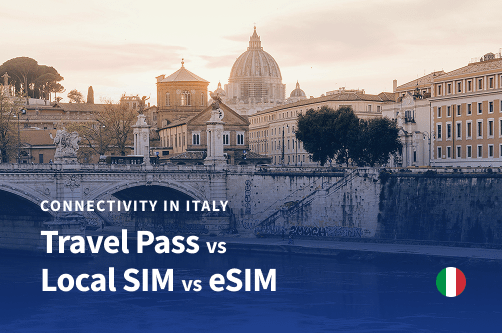
If you’re traveling to Italy in 2025, staying connected is essential. Whether you need maps, messaging, or video calls, your trip will run smoother with reliable data.
Based on our research, travelers typically have three main options:
The key question is: which of these works best for your trip? Let’s break it down.
Mobile data is the fuel behind the apps we use every day, from navigation to video streaming, and each app consumes it at different rates.
Some people only use small amounts of data for browsing or messaging, while others need large amounts to support video calls, cloud storage, and streaming. These two groups can be thought of as light data users and heavy data users.
Understanding which group you belong to will help you choose the right connectivity option for you.
For this guide, we classify:
Below is a table with some of the most commonly used apps and how much data they use per one hour of screen time.
| App | 1 Hour | Quality/Notes |
| Google Maps | ~3–5 MB | Standard navigation (default) |
| Spotify | ~43 MB | Normal quality (96 kbps) |
| Youtube | ~1.5 GB | 720p HD |
| Netflix | ~1 GB | 720p HD |
| What’sApp | ~200–300 MB | Video call |
| Zoom | ~500 MB–1 GB | Standard video meeting |
| ~600 MB | Browsing + posting | |
| TikTok | ~700 MB–1 GB | Browsing + posting |
| Google Drive | ~100–200 MB | File uploads/downloads |
| Dropbox | ~100–200 MB | Syncing documents/images |
After understanding how much data each of these apps uses, we can determine whether you are a light user or a heavy user.
To illustrate the difference, let’s look at two personas: Sarah, a heavy data user, and David, a light data user.
Sarah works remotely as a digital marketer and must stay connected for client meetings, file uploads, and social media campaigns, even while traveling in Italy.
David, on the other hand, does not work during their trip and mostly uses his phone for entertainment and navigation while Sarah is busy.
Here’s the difference between their data consumption:
David uses his phone mainly for leisure. On an average day, he might:
David’s daily total: ≈ 850 MB
Sarah works remotely as a digital marketer, so her usage is much higher. On an average day, she might:
Sarah’s daily total: ≈ 3 GB
Now, if David and Sarah went on a 10-day trip to Italy, their connectivity needs would vastly differ. Sarah would need to emphasize a strong connection without the option of losing service quality. David, who would be using the internet more for leisure and less for work, doesn’t need such a large (and potentially expensive) data package.
| Type of User | Daily Data Needs | 10-Day Trip |
| David (Light Data User) | 850 MB | 8 - 10 GB |
| Sarah (Heavy Data User) | 3 GB | ~ 30 GB |
With these two user profiles in mind, let’s return to our main question: which connectivity option works best in Italy?
We’ll now compare the three choices introduced earlier:
For each, we’ll look at:
Let’s start with the Travel Pass.
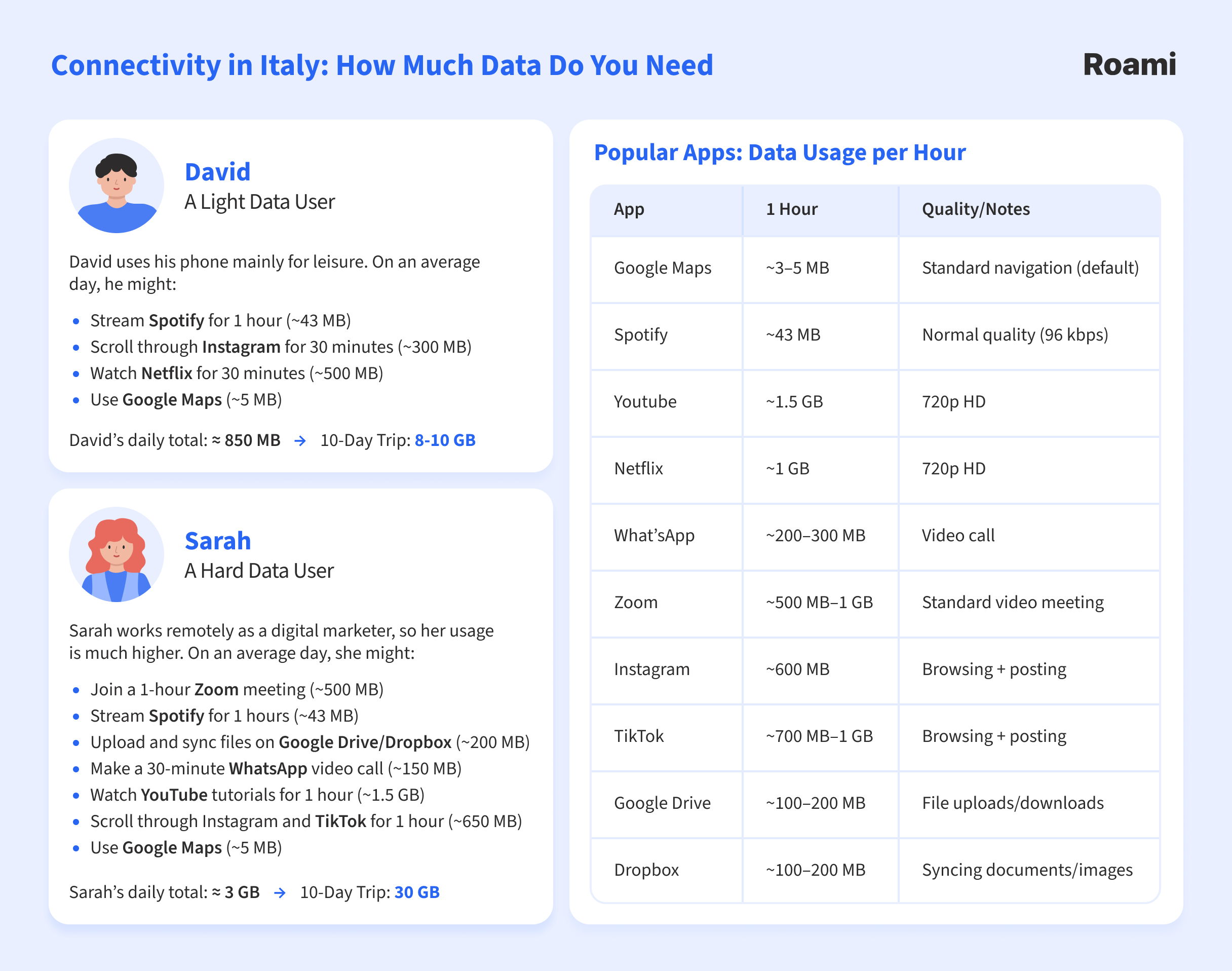
If you are a traveler from the United States, you might be using Verizon as your carrier. In that case, a Travel Pass or International Monthly Plan could be the easiest way to get online in Italy. These options require no setup, no SIM swaps, and no new apps. You simply land in Italy, turn on your phone, and it works just like at home.
Pros of a Travel Pass
Cons of a Travel Pass
When we look at some of the options Verizon offers, we can pick the two that stand out:
While the first option offers enough data for light and heavy users even after the speeds drop, the second option offers a cumulative 20 GB which are valid for the entire month. Data-wise, TravelPass would make sense, although it is pricier than other options.
An International Monthly Plan might be an overkill: if you are traveling for 10 days only, you don’t need data for the month.
| Plan | Data | Calls/Text | Price | Price for a 10-day trip |
| TravelPass | 5 GB per day (then 3GB) | Yes | $12 per day | $120 |
| International Monthly | 20 GB total (then 3GB) | Yes | $100 per month | $100 |
After a quick analysis of these roaming options, Sarah and David decided to look for alternatives for their trip in Italy; while technically both options could work for them, a 10-day trip didn’t justify staying connected for the month.
They turned towards local SIM cards.
Verdict: A Travel Pass is the simplest way to get online in Italy, but it comes at a premium. It’s worth it for short trips where convenience matters most, but long-term travelers will find better value in SIM or eSIM options.

Another option for staying connected in Italy is to purchase a local SIM card once you arrive.
Local SIMs give you access to Italian networks at domestic prices, which usually means much larger data allowances for far less money than international roaming.
To get one, you need to visit a mobile shop or kiosk, present your passport, buy a SIM, insert it into your phone, and go through an activation process.
Pros of Local SIMs
Cons of Local SIMs
| Provider | Data | Calls/Text | Duration | Price | Activation Fee (~$11) |
| Iliad Dati 350 | 350 GB | No | 30 days | ~$16.50 | Yes |
| TIM Tourist | 200 GB | Unlimited Local | 30 days | ~$27.50 | Yes |
| Vodafone Dolce Vita | 100 or 200 GB | Yes | 30 days | ~$18.70 / ~$30.80 | Yes |
Local SIM providers definitely offer the best deals when it comes to cost per GB. However, they also come with a unique set of challenges from finding the right kiosk and doing the setup in a foreign language to not having your internet connection set up and secured beforehand.
While leisure travelers can, perhaps, afford to find the right plan and connect sometime after they land, for those dependent on a strong and stable connection like Sarah, local SIM providers might not be the best option.
So, Sarah decided to look at alternatives: she found eSIMs
Verdict: Local SIM cards deliver the best value for heavy data users and longer stays, but setup can be inconvenient. Great if you don’t mind the hassle of visiting a store after landing and if you don’t need the internet right away.
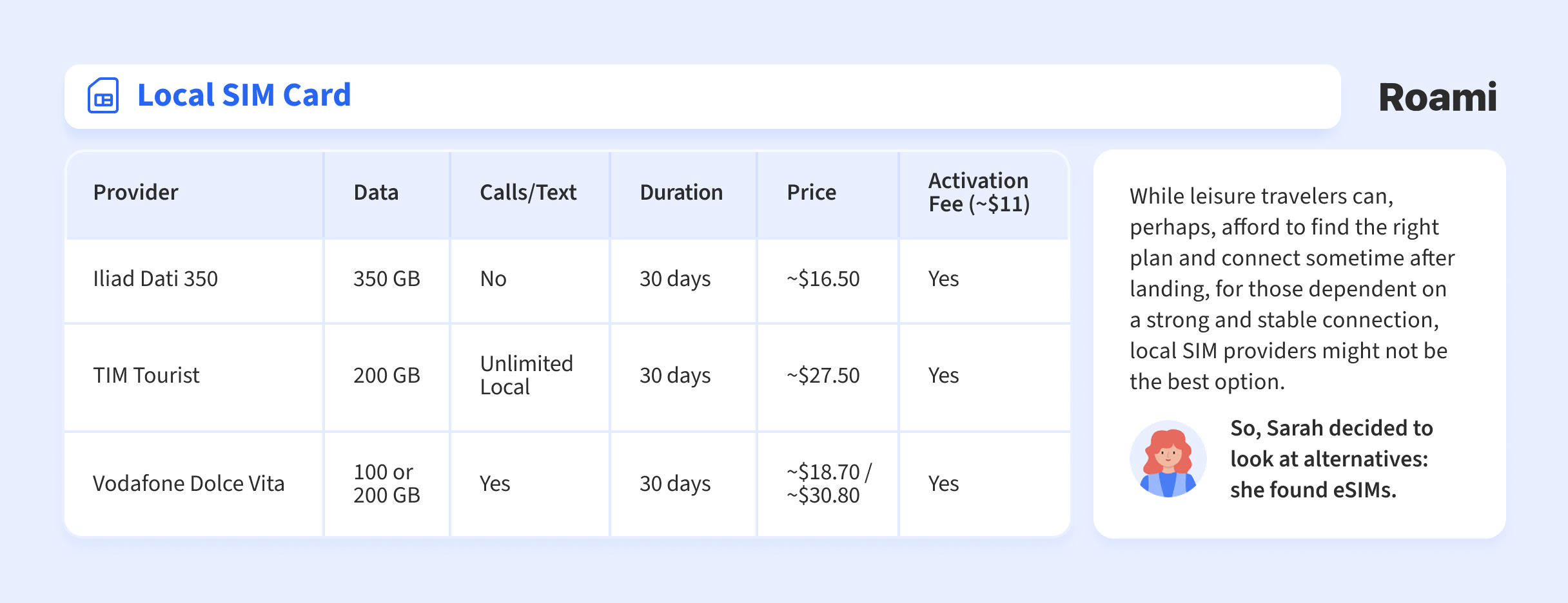
The third option for staying connected in Italy is to use an eSIM card. Unlike a physical SIM, an eSIM is a digital SIM profile built into your phone. This means you can purchase a plan online, scan a QR code, and activate your eSIM instantly without ever setting foot in a store.
eSIMs are especially convenient for travelers who want to arrive in Italy with the internet already working. While this option is often hassle-free, it does come with its own set of challenges: you must have a compatible phone and most plans don’t offer calls and text.
Pros of eSIMs
Cons of eSIMs
Verdict: eSIMs are the most flexible and hassle-free choice. Perfect for travelers who want to be connected as soon as they land. Unlimited plans like Holafly suit heavy users, while Airalo works best for light or budget-conscious travelers.
When choosing an eSIM for Italy, it’s important to look at three things: data allowances, price, and whether the provider offers flexibility like unlimited plans or regional coverage.
After reviewing the most popular choices, we narrowed it down to three providers that best represent the options travelers are most likely to consider:
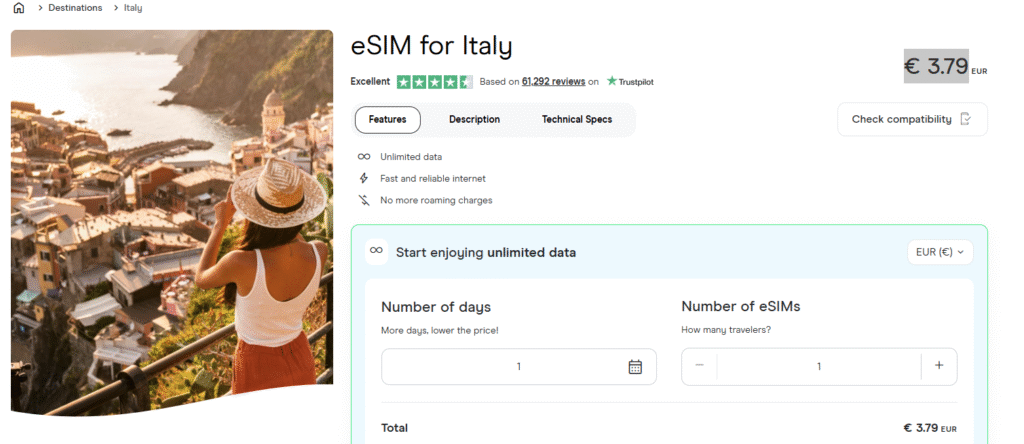
Holafly is one of the most recognized names in the travel eSIM market, and its appeal lies in the promise of unlimited data. For travelers like remote workers or social media creators, it offers peace of mind by removing the need to track every gigabyte.
While it is more expensive than other options, Holafly is popular because of its simplicity. You pay once, activate the eSIM, and do not worry about running out of data during the trip.
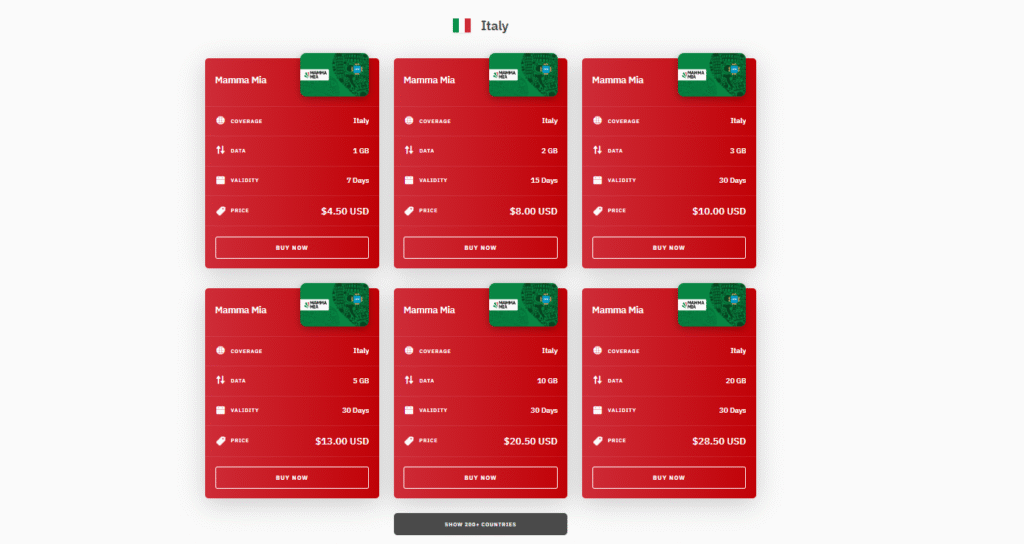
Airalo built its reputation as the budget-friendly choice for international travelers. Its strength is the wide range of packages, which start at just 1 GB for short trips and go up to 20 GB for longer stays.
This flexibility makes Airalo a favorite for light users who only need maps and messaging, but it also works for heavier users who want affordable mid-range data bundles. Airalo’s ease of use and transparent pricing make it an easy pick for cost-conscious travelers.

Maya Mobile is a newer but fast-growing eSIM provider that focuses on giving travelers flexible data options. It bridges the gap between budget and unlimited plans by offering 20 GB and 50 GB packages, as well as unlimited daily options with fair usage limits.
This balance appeals to those who want more security than Airalo’s capped plans but without the higher cost of Holafly. Maya is positioning itself as a flexible and traveler-friendly brand that emphasizes affordability without compromising reliability.
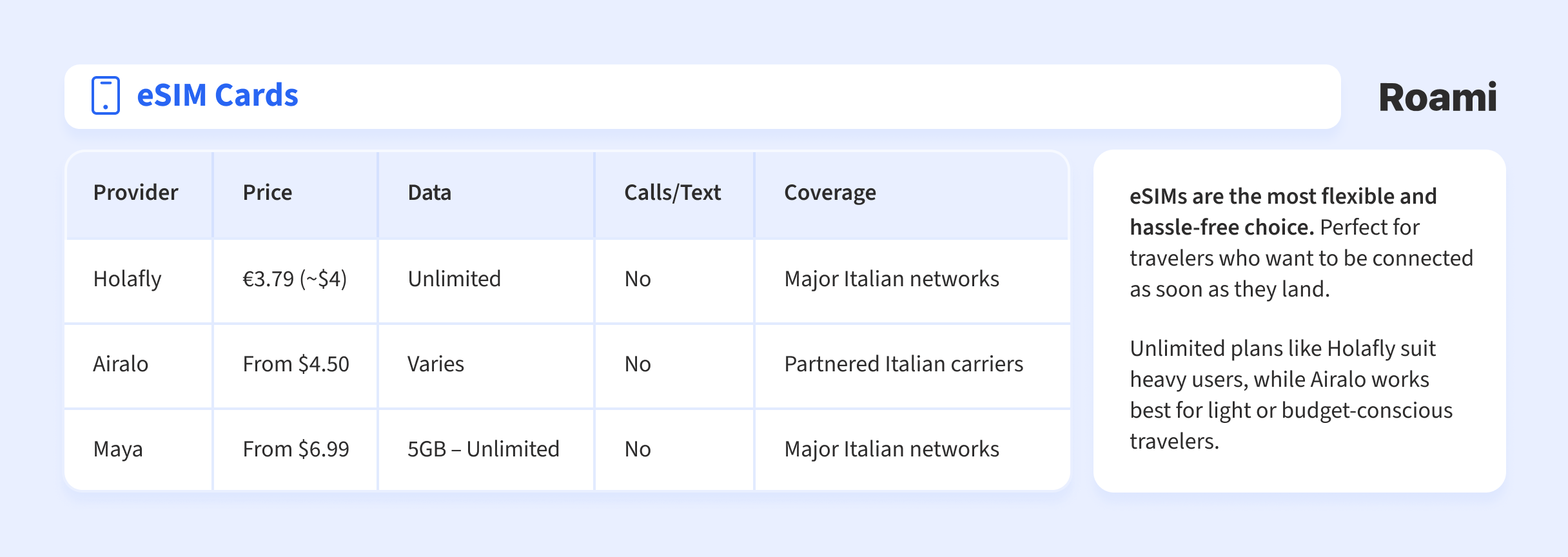
With so many ways to get online, it can feel overwhelming to choose the right one. To make the decision easier, here’s a side-by-side look at Travel Passes, Local SIM cards, and eSIMs for Italy in 2025.
| Option | Data and Price | Convenience | Calls & Text | Setup | Best For |
| Travel Pass | $12/day (≈€11) → 5 GB/day, then 3G | Very high (works instantly) | Yes, keep your own number | None (auto-activates) | Short trips, low effort |
| Local SIM | €15–30 → 100–350 GB for 30 days | Medium (must buy & register in Italy) | Yes, varies by plan | Passport registration, SIM swap | Long stays, heavy data use, budget travelers |
| eSIM | $4.50–$30+ → 1 GB to Unlimited | High (install QR before/after arrival) | Mostly data-only | Requires eSIM-compatible phone | Flexible users, remote workers, no-hassle setup |
Choose a Travel Pass if you want the absolute easiest solution, don’t mind paying more, and want to keep your home number active for calls and texts. Perfect for business travelers on short trips.
Choose a Local SIM if you’re staying 2+ weeks or need large amounts of data for the lowest cost. It’s unbeatable for value, but you’ll need to deal with setup in Italian stores.
Choose an eSIM if you want instant setup, no paperwork, and flexibility. Great for both light and heavy users, depending on the plan you pick. For digital nomads or remote workers, unlimited eSIMs like Holafly provide peace of mind.
See also: Rome Itinerary


